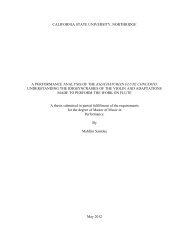Page 1 The California ""- Geographer Annual Publication of the ...
Page 1 The California ""- Geographer Annual Publication of the ...
Page 1 The California ""- Geographer Annual Publication of the ...
Create successful ePaper yourself
Turn your PDF publications into a flip-book with our unique Google optimized e-Paper software.
Mean Monthly and Seasonal Precipitation (in inches)<br />
(based on 1904-05 through 1954-55 period)<br />
------------------------------------ -- ------------- --<br />
July Aug. Sept. Oct. Nov. Dec. Jan. Feb. Mar. Apr. May J1me Season<br />
.II .17 .II .10 .18 .20 .24 .24 .19 .10 .06 .02 1.72<br />
Mean Monthly Temperatures (in F. o )<br />
(based on 1931 through 1952 period)<br />
Jan. Feb. Mar. Apr. May J=e July Aug. Sept. Oct. Nov. Dec. Year<br />
52.0 58.3 66.5 77.1 86.8 94.6 101.9 99.8 91.7 77.8 62.0 5'4.0 76.9<br />
Total Monthly Evaporation (in inches)<br />
(based on 1959 through 1963*)<br />
(summer half year only, with yearly totals)<br />
May J=e July Aug. Sept. Oct. <strong>Annual</strong><br />
---------<br />
!959 17.13 21.03 21.26 19.84 13.48 10.96 146.88<br />
1960 16.65' 21.34 22.71 21.51 14.69 10.09 147.21<br />
!96! 22.82 25.17 26.39 21.51 17.55 11.60 167.74<br />
!962 20.04 23.26 24.79 25.50 17.64 13.43 172.64<br />
1963 21.41 22.20 27.78 23.86 14.82 11.25' 168.23<br />
•- In May 1961 this station was moved slightly (new elevation-195') and renamed<br />
Death Valley. <strong>The</strong> trend at <strong>the</strong> new location seems to be for higher evaporation<br />
rates, as noted in <strong>the</strong> generally higher totals after 1960.<br />
Table T. Climatic Data, Cow Creek, Calif. (Eiev., Y 25')<br />
<strong>The</strong> criteria <strong>of</strong> at least three consecutive months with average maximum<br />
temperatures <strong>of</strong> 100°F. or over was set up by Russell as <strong>the</strong> boundary between<br />
B\iVh and BWhh climates. Five <strong>of</strong> <strong>the</strong> several <strong>California</strong> climatic<br />
stations that fall into this "very hot" category and <strong>the</strong>ir mean monthly<br />
maximum temperatures for <strong>the</strong> warmest months can be noted in Table 2.<br />
Mean Monthly Maximum Temperatures (in F.0) at Selected <strong>California</strong> BWhh Stations<br />
(based on 1931 through 1952 period)<br />
Station Elevation Apr. May June July Aug. Sept. Oct.<br />
Cow Creek -125 90.5 100.3 108.5 115.7 113.8 106.5 91.8<br />
Brawley -ll9 88.1 96.4 103.7 109.6 107.9 103.9 92.2<br />
Indio (U.S.<br />
Date Garden) II 87.4 94.6 101.2 107.3 105.6 101.9 92.0<br />
Bly<strong>the</strong> 266 88.3 95.9 102.8 108.5 106.7 102.6 91.3<br />
Iron Mom1tain 922 84.7 93.5 101.5 107.3 !05.5 100.4 82.5<br />
Table 2<br />
A sub-symbol that Koppen originated for use with "A" climates was<br />
also found to be applicable in <strong>California</strong>. This is <strong>the</strong> small "m" for monsoon<br />
type precipitation (in this case, with reference to heavy seasonal<br />
precipitation). Precipitation data from various stations in nor<strong>the</strong>rn<br />
<strong>California</strong> were plotted on a graph (Figure 2) by utilizing Koppen's<br />
formula for delimiting "m" areas. It was found that in <strong>the</strong> north coastal<br />
area two separate regions, one in Del Norte County and extreme western<br />
Siskiyou County (east <strong>of</strong> Crescent City) and <strong>the</strong> o<strong>the</strong>r in Humboldt<br />
County (sou<strong>the</strong>ast <strong>of</strong> Eureka), have this type <strong>of</strong> climate (See Figure I).<br />
4













